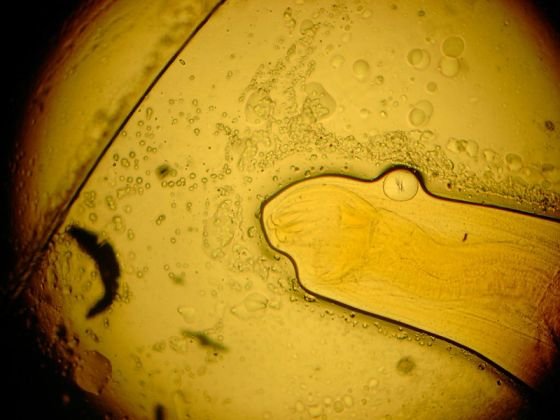One in a hundred cats in the USA is infected with hookworms, according to the Companion Animal Parasite Council. That might sound like a low prevalence rate. But the effects of hookworms in cats can be devasting, especially if left untreated.
I put together this article to help you understand the nature of hookworms in cats. I’ll also tell you what you can do to protect or cure your cat from the blood-sucking intestinal parasite.
What are Hookworms?

Hookworms are parasites that dwell in the intestines of cats and dogs. Their name describes the hook-like mouth they use to attach to the intestinal wall lining.
Compared to other intestinal parasites like roundworms and tapeworms, hookworms are quite tiny in size. They measure around an eighth inch (2-3mm), making them hard to notice with the naked eye.
Ancylostoma tubaeforme and Ancylostoma braziliense are the most common hookworms in cats. The names of the two common feline hookworms explain why hookworm infection in cats is sometimes referred to as Ancylostomiasis.
Rarely, cats also get infected with two types of dog hookworms, Ancylostoma caninum, and Uncinaria stenocephala. These are worse bloodsuckers than cat hookworms.
In the cat’s intestines, ancylostoma hookworms live by sucking their host’s blood and other tissue fluids.
How do Cats Get Hookworms?
Female hookworms produce eggs in large numbers. These eggs are passed through the feces of the host. Once deposited into the environment, they hatch into larvae that can find their way to other cats and pets.
Cats will get infected with hookworms by:
- Ingesting contaminated water and food.
- Swallowing hookworm larvae while grooming their feet.
- Hunting and eating hookworm-infected rodents.
- Walking on soil that harbors hookworm larvae which then penetrate the cat’s skin.
- Ingesting hookworm larvae in the mother’s milk (for young kittens).
Ingested hookworm larvae go into the cat’s small intestines to complete their life cycle. Hookworm larvae burrowed under a cat’s skin can also migrate to the trachea or lungs. These are then coughed up and swallowed, finding their way into the intestines.
What are the Signs and Symptoms of Cat Hookworms?

Not every cat will show signs of hookworm infection immediately. However, once the worm burden in your cat has increased, certain signs and symptoms will point to hookworm infection. These include:
- Lesions between the toes and under the paws where hookworm larvae have entered the cat’s skin.
- Diarrhea and constipation.
- Tarry stool, is a sign of blood from a wounded intestinal lining when hookworms feed.
- Poor coat appearance.
- Loss of appetite.
- Weight loss or retarded growth in kittens.
- Anemia from blood loss when hookworms attach/detach from the intestinal lining. It is estimated that a single hookworm can cause up to 0.1 mL of blood loss in 24 hours. The lining of the lips, ears, and nostrils may be pale from anemia.
- Coughing is an indication of hookworm larvae migration to the lungs.
- A general unhealthy appearance.
Left untreated, hookworm infection in cats can turn fatal. This is most common in kittens, older cats, and those with underlying health conditions.
To preempt complications from hookworm infection, bring your cat to the veterinarian for a proper diagnosis if you notice the above signs. This should be done as an emergency if your cat has not been dewormed for a while.
How is Hookworm in Cats Diagnosed?
Diagnosing hookworms in cats is usually done through fecal floatation. The cat’s stool is then scrutinized under a microscope to detect the presence of hookworm eggs.
Some veterinarians also use PCR (Polymerase Chain Reaction) or antigen test to examine the cat’s stool for hookworm DNA. This is a more sensitive test and provides more accurate results, especially where hookworm eggs are not detected through fecal floatation.
Once a positive diagnosis of hookworms is given, the vet may request additional tests. Complete bloodwork will determine your cat’s hemoglobin levels and rule out anemia. The test will also indicate any other hookworm-related health issues.
Hookworm Treatment for Cats
The broad-spectrum dewormer Drontal is used for the treatment of hookworms in cats. How often worm cat Drontal is administered should be determined by a vet. The prescription is also safe for kittens.
Pyrantel Pamoate (Nemex®/ Nemex 2®) is also prescribed for the treatment of cat hookworms. Fenbendazole (Panacur®/Safe-Guard®) is sometimes used ‘off label’.
In severely affected cats, treatment may include blood transfusion and the use of nutritional supplements.
Can Hookworms in Cats be Prevented?
The sure way to protect your cat from getting hookworms is to eliminate the conditions for infection. This can be achieved through the following ways:
- Ensure your cat’s litter box and living area are always clean.
- Keep your environment clean by removing any fecal matter from cats and other pets from your compound.
- Faithfully administer the recommended broad-spectrum dewormers throughout the year. Talk to your cat’s vet for an appropriate prescription.
- Keep your cat healthy with a balanced diet. A robust immune system helps your cat fight infections.
- Test your cat for hookworms and other intestinal parasites frequently. The CAPC (Companion Animal Parasite Council) recommends testing your kitted for hookworm at least 4 times in the first year and twice annually after that.
- Limit your cat’s outdoor visits, as this increases the chances of coming into contact with infected material or animals.
Final Word
Hookworms have zoonotic potential. Although cat hookworms do not infect humans as intestinal parasites, hookworms in cats can be transmitted to humans as a skin infection.
Specifically, hookworm larvae burrow under human skin and cause cutaneous larval migrans (ground itch). As such, effective control of cat hookworms is essential for your health and your family’s.
Featured Image Credit: Microrao, CC BY-SA 4.0, via Wikimedia Commons
